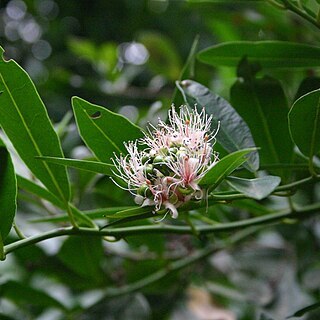Shrubs, sometimes scandent, 0.6-3 m tall. Twigs thick, zigzagged, with dense ash-yellow pubescence when young then glabrescent. Stipular spines 2-5 mm, stout, sharp, recurved. Petiole 3-6 mm, densely shortly pubescent; leaf blade oblong-elliptic, oblong-ovate, or sometimes linear-oblong, 2-5(-7) × (0.8-)1-2(-3.2) cm, herbaceous to subleathery, abaxially with persistent trichomes at least on midvein, adaxially pale green when dry, glabrous or soon glabrescent, and slightly shiny, midvein abaxially raised and adaxially flat but slightly impressed near base, secondary veins 4-6(-9) on each side of midvein and slender, reticulate veins not obvious, base cuneate, rounded, or sometimes slightly cordate, apex obtuse, rounded, or often emarginate. Inflorescences terminal on lateral shoots, subumbellate or shortly racemose, sessile, (6-)10-22(-25)-flowered; rachis 0.5-3.5 cm, densely pubescent. Flowers fragrant. Pedicel 0.8-2 cm, slender, glabrous. Sepals ovate, 3-5 × 3-4 mm; sepals of outer whorl concave, herbaceous, glabrous, margin narrowly membranous; sepals of inner whorl slightly smaller, thin, margin broadly membranous. Petals white, oblong-obovate, 4-6 × 1.5-3 mm, membranous, ± pubescent. Stamens 25-45; filaments 5-6 mm, rather crinkled; anthers ca. 0.5 mm. Gynophore 7-10(-12) mm, slender, often shortly pubescent near base; ovary ovoid, ca. 1.5 mm, glabrous; placentae 2. Fruit dark brown when dry, globose, ca. 1 cm in diam., smooth; fruiting pedicel slender, 1-1.5 cm; fruiting gynophore 4-10 mm. Seeds 1-4 per fruit, 6-8 × 3-4 mm. Fl. Apr-Jun, fr. Aug-Dec. 2n = 40.
Scrambler or dense shrub with branches often c. 5 m long. Branches with white spreading hairs to glabrous, with recurved thorns pubescent, becoming glabrous. Leaves alternate, spirally arranged; lamina lanceolate, elliptic or oblong, usually abruptly constricted at both ends, rarely with pointed apex, often emarginate, 2-7(-8) cm long, 1-3 cm broad, glabrous to hairy especially on the lower surface, with 5 or more pairs of secondary veins joining the primary vein at almost right angles, margin usually revolute; petiole 0.2-0.7 cm long, pubescent at least in the groove at the top. Inflorescence terminal, corymbose to subumbellate; pedicels 1.2-2.5 cm long, glabrous or with spreading hairs. Sepals orbicular to obovate, outer ones broader than inner, 3-6 mm long, glabrous, sometimes with ciliate margin. Petals oblong, obovate, 5-8 mm long, hairy mainly within, villose at the base. Stamens 30-50; filaments 0.8-1.5 cm long. Gynophore 0.5-1(-1.5) cm long, glabrous. Ovary ovoid with 8-30 ovules; style short, tapering into a small stigma. Berry spherical or almost so, 0.6-1.5 cm in diameter, glabrous, soft, purplish-black with 1-2, rarely more seeds.
Spreading or scrambling, much branched shrub, 3–4 m. tall with branches to 10 m. long.. Young twigs glabrous or appressed-to spreading-pubescent.. Leaves petiolate; blade elliptic, ovate, oblanceolate to obovate or suborbicular, 1.2–7 cm. long, 0.7–4 cm. wide, generally rounded, emarginate, with the midrib frequently terminating in a minute mucro, rounded to subcordate at the base; petiole 2–6 mm. long.. Flowers in racemose often corymbose clusters of 2–20 or more, terminal on the main and short reduced lateral shoots, sometimes solitary in the leaf-axils below; pedicels 4–25 mm. long, glabrous or pubescent.. Sepals 4–8 mm. long, glabrous or variously pubescent with a scarious or ciliate margin.. Petals oblong or oblong-spathulate, 5–8 mm. long, pubescent at the base, with the upper part usually glabrous outside and pubescent within.. Stamens 30–40, 7–14 mm. long.. Gynophore 8–15 mm. long in flower, up to 9–15 mm. long, 1–2 mm. thick in fruit.. Fruits globose, 9–12 mm. in diameter, crustaceous.
Shrub to 6 m high, sometimes climbing; twigs densely puberulous, glabrescent. Spines 2–8 mm long, recurved. Leaves linear, elliptic, ovate or obovate, usually notched, 1.5–10 cm long, 0.5–4 cm wide; indumentum wearing off above, persistent below; base acute to subcordate; midrib sometimes sunken at base; veins 4–8 pairs; petiole 1–7 mm long. Inflorescences subumbellate on lateral twigs, rarely terminal, of up to 25 flowers; pedicels 7–30 mm long, glabrous. Sepals ovate, 3–6 mm long, sometimes minutely ciliate. Petals 4.5–7.5 mm long, 1–3 mm wide, pubescent, white. Stamens 30–45, equal to gynophore. Gynophore 4–15 mm long, often puberulous at base; ovary ovoid, 1.5–2 mm long, glabrous; placentas 2 or 3. Fruit subglobose, 10–15 mm diam.; pericarp subcoriaceous, smooth. Seeds 1–2; axis through attachment c. 5 mm long.
Shrub, climber or scrambler, height variable; branches with white spreading hairs to glabrous, thorns recurved, pubescent, becoming glabrous. Leaves alternate, spirally arranged; petiolate; glabrous to hairy especially on lower surface; lanceolate, elliptic or oblong, margins revolute. Inflorescence terminal, corymbose to subumbellate, pedicellate. Sepals orbicular to obovate, outer ones broader than inner ones, glabrous, margins sometimes ciliate. Petals oblong, obovate, hairy within, villose at base. Stamens 30-50. Ovary ovoid. Flowering time Sept.-Dec. Fruit a spherical berry, glabrous, soft, purplish black.
Leaf-lamina 1.2–5 x 0.4–2.8 cm., lanceolate, oblong-elliptic or elliptic, rounded or emarginate at the apex, rounded or slightly cordate at the base, appressed-pubescent on both sides; petiole up to 5 mm. long, appressed-pubescent.
Flowers 4–6 which are together in condensed racemes, terminal or often on short side branches 2–4 cm. long, or single in the axils of the upper leaves; pedicels up to 2 cm. long, slender, glabrescent.
A shrub or climber. It is thorny. The leaves are oval to sword shaped. The flowers are white. They are in groups with very short stalks. The fruit is round and smooth. They are yellow to black.
Thorny, much branched or subscandent shrub to 6 m. tall or sometimes climbing over tall trees; young branches green and smooth, glabrous or with an appressed pubescence on the young parts.
Sepals 4–6 mm. long, concave, orbicular, membranous-margined, glabrous or almost so, sometimes minutely ciliolate on the margins.
Petals up to 8 mm. long, spathulate, rounded at the apex, pilose within and at the margins, more densely so towards the base.
Thorny shrub or scrambler to 5 m. Leaves elliptic, margins often revolute. Flowers in terminal corymbs, hairy, white.
Seed usually single, c. 6 mm. in diam., discoid, brown, smooth.
Ovary ovoid, sometimes oblique, with an apiculate stigma.
Stamens 40–50, with slender filaments c. 1.3 cm. long.
Gynophore about the same length as the stamens.
Fruit yellowish, 1–1.3 cm. in diam., globose.
Buds globose.


